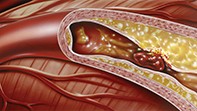Peer Reviewed
Case studies
Challenging cases in lipid management and CVD prevention: a retrospective and an update
Abstract
Case studies representing challenges in lipid management and cardiovascular disease prevention that have already been published in Cardiology Today are revisited to see whether the key messages remain current and to give updates as necessary.
Key Points
- Statin drugs form part of the standard cardiovascular disease therapy, especially in high-risk patients.
- A small proportion of patients receiving statin therapy will manifest adverse events, notably myalgia, liver dysfunction or central nervous system symptoms. In some instances therapy cannot be continued.
- Patients with familial hypercholesterolaemia are often unable to achieve goal lipid levels and novel therapy with an inhibitor of the key protein PCSK9 holds hope for the future. This therapy may also be helpful in patients unable to tolerate statins.
- In patients with severe hypertriglyceridaemia, fenofibrate may be a relevant therapy if underlying problems such as high alcohol intake, diabetes or obesity have been excluded or resolved.
- Overly sensational and unbalanced media reporting continues to alarm patients who are taking statins, often leading to cessation of therapy.
- Novel risk factors such as lipoprotein(a) and homocysteine should be assessed if patients have unexplained coronary artery disease.
- Use of statins in the elderly requires empirical clinical judgements, often in the absence of strong clinical evidence.
Picture credit: © SPL/John Bavosi/Diomedia.com
Purchase the PDF version of this article
Already a subscriber? Login here.

